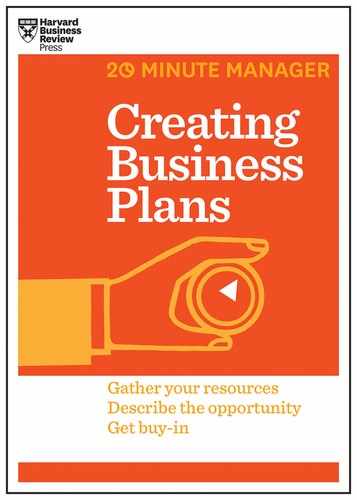Test Yourself
Below you’ll find 10 multiple-choice questions to help you assess your knowledge of creating business plans. Answers appear after the test.
1. A mission statement, which describes what your business is about and its philosophy and vision for the future, is best placed in the:
a. Executive summary
b. Marketing plan
c. Operations plan
2. To impress potential investors, include detailed, month-by-month financial projections and forecasts for at least 10 years. True or false?
a. True
b. False
3. The balance sheet is:
a. Also known as a pro forma profit and loss statement.
b. An expression of the business’s assets and liabilities.
c. A statement that shows the times of peak need and peak availability of cash flow.
4. Weighing the cost to acquire a customer against the long-term value of that customer helps you:
a. Decide which marketing strategies are most appropriate.
b. Better understand your competitors’ sales strategies.
c. Develop a realistic operations plan.
5. The ________ is the minimum rate of return that is expected of all projects in a company.
a. Hurdle rate
b. Gross margin
c. Return on investment
6. The management summary is best executed as an attachment that includes the résumés of your management team. True or false?
a. True
b. False
7. A financial tool that shows the point at which your business or venture is expected to neither be losing money nor making money is a:
a. Risk/ Return graph.
b. Cash flow analysis.
c. Breakeven analysis.
8. When researching the competitive outlook for your industry, it’s wise to consider:
a. How much of a threat your competitors pose to your venture.
b. Whether your competitors will aggressively block your entrance into the market.
c. Who else might be able to observe and exploit the same opportunity that your new venture will capitalize on.
d. All of the above.
9. The executive summary portion of your business plan is best written after you draft the rest of the plan. True or false?
a. True
b. False
10. When you’re developing the milestones for your business plan, it’s generally advisable to do all of the following except:
a. Include only major events, not every individual step.
b. Use actual dates.
c. Leave time in the schedule for the unexpected.
d. Develop an ambitious schedule you can meet.
Answers to test questions
1: a. An executive summary is a concise description of what your company is, where you want it to go, and why it will be successful. It gives readers an understanding of your proposal, and—importantly—captures their interest in your new venture, which is why it’s the best place for a mission statement.
2: b. Be careful not to devote too much space to numbers and too little to the information that matters most to potential investors. Most reviewers are well aware that financial projections for a new company, especially comprehensive, month-by-month forecasts that extend for years and years, are little more than optimistic fantasies.
3: b. The balance sheet is an expression of a business’s assets and liabilities. Assets include items like ready cash, accounts receivable (money owed to you), inventory, and real estate. Liabilities include things like debts from outstanding loans.
4: a. Weighing the cost to acquire a customer against the long-term value of that customer helps you decide which marketing strategies are most appropriate.
5: a. The company’s hurdle rate is the minimum rate of return expected for all projects. If a project or venture doesn’t pass the company’s hurdle rate, it may not get approved or funded.
6: b. Many investors say that the management summary is one of the first sections of a business plan they read, so take special care to craft one that demonstrates how leaders will make the business work as a finely formed, dynamic unit.
7: c. The breakeven point is the pivotal moment when a business can begin to earn a profit. Readers want to know when and at what level of sales that will occur, and this form of analysis enables you to provide that information.
8: d. All of the above. Also consider whether rivals will recognize the attributes that set you apart and appropriate them for their own products or services.
9: a. The executive summary should be a concise presentation of the major points in your business plan, so it is best written last. If you were to write it at the beginning, you’d probably end up making significant revisions later.
10: b. It’s generally not advisable to use hard dates in the milestone portion of your business plan because specific dates aren’t always needed, and they leave you less wiggle room. Instead, use generic dates, such as six months or one year.
